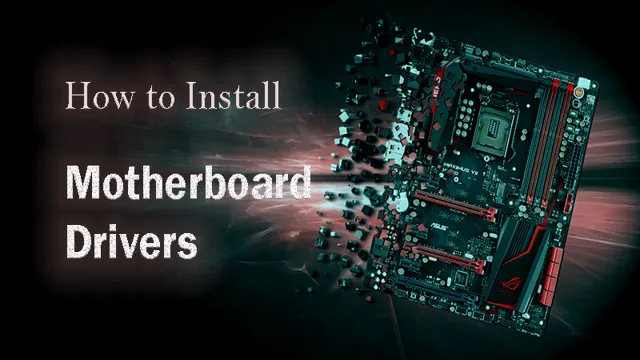Ready to build your own PC? Installing a motherboard driver is an essential step in this process, but it can be a bit confusing for beginners. Don’t worry, I’ve got you covered. In this blog post, I’ll guide you through the process of installing your motherboard driver in a simple and easy-to-understand way.
By the end of this post, you’ll have your own working computer, and you’ll feel like a tech wizard. So, let’s dive in!
Check Your Motherboard Model
Installing motherboard drivers is a crucial step in setting up your computer. To begin, you need to check your motherboard model. This can easily be done by checking the documentation that came with your motherboard or by running system information software.
Once you have identified your motherboard model, you can proceed to download the appropriate drivers from the manufacturer’s website. It’s important to note that if you install the wrong drivers, your PC may malfunction, so be sure to double-check before proceeding. Once you have downloaded the correct drivers, simply run the setup file and follow the on-screen prompts.
After the installation is complete, be sure to restart your computer to ensure the changes take effect. With these simple steps, you’ll have your motherboard drivers installed and your PC running smoothly in no time.
Find the Latest Driver Version for Your OS
If you’re looking for the latest driver versions for your operating system, the first step is to check your motherboard model. This will help you identify which drivers are compatible with your system. You can usually find the model number printed on the motherboard itself or in the documentation that came with it.
Once you have this information, you can search for the latest driver updates on the manufacturer’s website. Keep in mind that different versions of the same driver may be available for different operating systems, so make sure you download the one that’s right for you. Updating your drivers can help improve system performance, fix bugs and security issues, and add new features.
So, don’t forget to check for updates regularly and keep your system running smoothly.

Download the Driver
When it comes to downloading drivers for your motherboard, the first step is to check your motherboard model. This will ensure that you download the correct driver for your specific motherboard. To check your motherboard model, you can look at the documentation that came with your motherboard or use a system information tool to find the model number.
Once you have determined the model number, you can visit the manufacturer’s website to download the appropriate driver. It’s important to note that downloading the wrong driver can cause issues with your system, so it’s crucial to ensure that you have identified the correct model number. By taking the time to check your motherboard model, you can avoid potential issues and ensure that your system runs smoothly with the latest and correct drivers installed.
Install the Driver
So you’ve just finished building your dream PC, and now it’s time to install the motherboard driver. Without this crucial piece of software, your computer won’t run smoothly or efficiently. The good news is that installing the driver is a quick and easy process.
First, find the motherboard driver on the manufacturer’s website and download it onto your computer. Then, unzip the file and double-click on the setup.exe file to begin the installation process.
Follow the on-screen instructions, and restart your computer once the installation is complete. That’s it! You’re now ready to enjoy your new PC experience with all the necessary drivers installed. Remember, it’s important to keep your drivers up to date to ensure optimal performance.
So, make sure to check for updates periodically on the manufacturer’s website. Happy computing!
Extract the Files
When it comes to installing a new device on your computer, the first step is often to extract the files from the downloaded package. This is particularly true when it comes to drivers, which are essential for ensuring that your hardware can communicate properly with your computer’s operating system. To extract the files, you’ll need to locate the downloaded package and either use your operating system’s built-in extraction tool or a third-party utility such as 7-Zip or WinZip.
Once you’ve extracted the files, you’ll be ready to move on to the next step: actually installing the driver. This can vary depending on the device and operating system you’re using, but in most cases you’ll either need to run an installer or manually update the device’s driver in the Device Manager. By taking the time to properly extract and install your driver, you can ensure that your hardware is functioning optimally and providing you with the best possible performance.
Run the Installer
After downloading the correct driver for your device, the next step is to run the installer. By doing so, the driver package will be unpacked and installed onto your system. This may involve clicking through some prompts and accepting terms and conditions before the installation can begin.
Many installers also offer the option to customize the installation settings, allowing you to choose which components and features you want to install. Once the installation is complete, you may be prompted to restart your system to ensure that the driver is properly integrated. It’s important to follow all instructions carefully during the installation process to ensure that the driver is installed correctly and your device is functioning properly.
Remember, always keep your drivers up-to-date to ensure the best performance and stability from your device.
Reboot Your PC
When it comes to installing drivers for your computer, it’s important to follow a few simple steps to ensure that everything goes smoothly. One of the first things you should do is reboot your PC after installing the driver. This will help to ensure that the driver is properly installed and that everything is running smoothly.
Additionally, you may want to consider installing any necessary updates or patches before installing the driver. This will help to ensure that your system is up-to-date and that you have all of the necessary components for the driver to function properly. Without rebooting your PC after installing the driver, you may run into problems with your computer’s performance.
You might find that certain programs are slower to load or that your computer is freezing up more frequently. This is because the driver may not have been properly installed or may not have fully loaded into your system. By taking the extra step to reboot your PC after the installation, you can help to ensure that everything is working as it should.
Installing drivers may seem intimidating at first, but with a little bit of patience and attention to detail, you can get it done in no time. Start by finding the correct driver for your device and operating system, then follow the installation instructions carefully. If any issues arise, don’t hesitate to reach out to customer support for assistance.
With a little bit of effort and attention, you can easily install drivers and optimize your system for improved performance.
Test Your Installation
So you’ve just installed a new motherboard, but how do you know if everything is working properly? One important step is to test your installation by checking and installing the necessary drivers. To install a motherboard driver, you’ll first need to identify the brand and model of your motherboard. This can usually be found on the box it came in or on the motherboard itself.
Once you have this information, visit the manufacturer’s website and search for the appropriate driver for your motherboard. Download and install the driver, and then restart your computer. You can check that the driver has been successfully installed by opening the Device Manager and looking for any yellow exclamation marks on your motherboard device.
If everything looks good, you’re ready to start using your newly installed motherboard!
Check Device Manager for the Driver
When you install a new device, it is important to check if the driver is properly installed on your computer. To do this, you can open the Device Manager and look for the driver. The Device Manager lists all the hardware devices connected to your computer, and it shows you which drivers are working properly and which ones are not.
If the driver is installed correctly, it will show up in the list with no errors or warnings. However, if the driver is missing or outdated, you will see a yellow exclamation mark next to it. This means that you need to update the driver or install it again to fix the issue.
Checking the Device Manager can help you troubleshoot driver issues and ensure that your devices work smoothly with your computer.
Test the Functionality
After successfully installing any software, it is crucial to test its functionality to ensure that everything is working smoothly. The same goes for the installation of any programmatic language. Therefore, after installing your programming language, the next step is to undertake steps to test your installation.
One of the most convenient ways to accomplish this is to utilize a command-line interface or terminal. By executing simple commands like the version command, you can determine if the installation of your programming language was successful, and also ascertain the version you installed. You can also run a simple “Hello World” program to ascertain the functionality of the installation.
Testing your installation before diving into writing complex programs saves time and resources, as it will help detect any installation errors early on, making it easy to fix them before you have a significant project underway. By putting your installation through its paces, you’ll be able to handle more sophisticated programming tasks with confidence.
Conclusion
Congratulations! You’ve made it to the end of this guide on how to install a motherboard driver. Now that you understand the importance of having the latest motherboard driver and the steps involved in installing it, you’re ready to take on any hardware challenge that comes your way. So, embrace the power of technology and take a deep breath – motherboard driver installation may seem daunting, but with a little patience and a lot of coffee, even the most complicated issues can be conquered.
Now go forth and enjoy your speedy, glitch-free system!”
FAQs
What is a motherboard driver?
A motherboard driver is a software program that allows the operating system to communicate with the motherboard and its components.
Do I need to install a motherboard driver?
Yes, it is essential to install a motherboard driver for optimal system performance.
How do I install a motherboard driver?
First, download the appropriate driver file from the manufacturer’s website. Then, run the installer and follow the prompts to install the driver.
Can I use a motherboard driver from a different manufacturer?
No, it is not recommended to use a motherboard driver from a different manufacturer as it may cause compatibility issues.
What should I do if I encounter issues with the motherboard driver?
Try uninstalling and reinstalling the driver. If the issue persists, contact the manufacturer’s support for further assistance.


